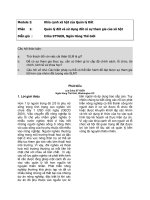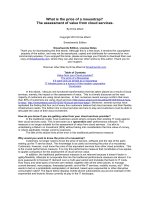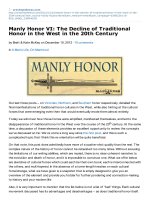The Handbook of News Analytics in Finance pptx
Bạn đang xem bản rút gọn của tài liệu. Xem và tải ngay bản đầy đủ của tài liệu tại đây (4.98 MB, 386 trang )
Preface
‘‘This is a timely—and exciting—book. The technology of extracting financial sentiment
from news feeds and other such sources is one that has been slowly growing, supported by
the accelerating infrastructure provided by the world wide web. Over the past ten years or
so, papers have been appearing showing that useful information can be extracted in this
way. Moreover, one can legitimately expect the rate of progress to gather pace, as other
supporting web technologies continue to develop.
This book is the first to provide a comprehensive overview of the state of the art. It will
attract a lot of attention. From a technical perspective, the area presents some deep and
interesting challenges, which are nicely captured here. One is the central issue of fusing
entirely different kinds of information, from quite distinct sources, and with very different
degrees of reliability. Another is an issue which mining of large observational data sets has
to contend with, whatever its area of application, namely the problem of selection bias: it is
all too easy to extract a distorted, non-representative data set, so that any analyses based
on it are at risk of mistaken conclusions. Overall, this technology is still in its infancy, but
the papers presented in this volume provide a perfect launch pad for the future of news
analytics in finance.
Just as social statistics enables us both to define and measure the aggregate phenomena
that define society, so the work described in this volume will enable us to discern and
quantify the forces which steer financial markets.’’
Professor David J. Hand, Professor of Statistics, Imperial College, London;
Chief Scientific Advisor, Winton Capital Management; and
President, Royal Statistical Society
‘‘This cutting edge collection of writings offers important insights into the connection
between news analytics and sentiment that are rich, deep, and systematic. Investors and
academics alike have much to learn from reading this fascinating book.’’
Hersh Shefrin, Mario L. Belotti Professsor of Finance, Santa Clara University,
Leavey School of Business
‘‘Stop the press ! At last, we have a substantive book on financial news. This scholarly
treatise reaches way beyond how to read the stock pages to provide modern insights on the
relationship between news and price formation.’’
Peter Carr, Global Head of Market Modeling, Morgan Stanley and
Executive Director, Masters in MathFinance, NYU
‘‘Technological progress enhances human efficiency including the efficiency of our markets.
Trading on news is an integral part of such progress and The Handbook on News Analytics
is a welcome compendium on where we stand with regard to the risks and rewards of news in
markets.’’
Dilip B. Madan, Professor of Finance, Robert H. Smith School of Business and
Consultant to Morgan Stanley and Caspian Capital
‘‘The world runs on information and few areas as directly so as in finance. Now that
technology and quantitative techniques have caught up to the live news feed, this volume
will be an indispensible addition to the practitioner’s library.’’
Matthew Lee, Head of Research Global Index Equity, BlackRock
‘‘News sentiment is a largely new and unexplored class of data for use in quantitative
automated trading. This is a very thorough exploration of what we expect to be a critical
element of quantitative trading in the coming years. This book is filled with information and
insights that will be of great value to both professional quants and academic researchers.’’
Steve Bright, Ph.D., Vice President of Quantitative Research, Hyde Park Global
Investments LLC
‘‘Quantitative equity portfolio management’s continual evolution relies upon the discovery
and exploitation of stock price anomalies based on significant systematic investor mis-
perceptions. A vital, and relatively recent, aspect of this process involves exploring the
efficacy of non-quantitative information sources, a task for which this book is a particularly
important contribution. This volume serves as a very useful introduction to a timely and
fascinating area of investment research.’’
Peter Swank, Ph.D., Tudor Investment Corporation
‘‘During the 200 milli seconds a human is reading the latest news headline, a trading bot will
have dow nloaded the entire article, analyzed its meaning, and traded based on the content.
This is our world now, and this excellent book is the first to reveal the software, statistics,
and strategies driving advances in quantitative news trading.’’
Richard L. Peterson, M.D., MarketPsy Capital LLC and MarketPsych Data
Edited by
Gautam Mitra and Leela Mitra
The Handbook of News Analytics
in Finance
A John Wiley and Sons, Ltd, Publication
This edition first published in 2011
Copyright 2011 John Wiley & Sons Ltd
Registered office
John Wiley & Sons Ltd, The Atrium, Southern Gate, Chichester, West Sussex, PO19 8SQ, United Kingdom
For details of our global editorial offices, for customer services and for information about how to apply for
permission to reuse the copyright material in this book please see our website at www.wiley.com
The right of the authors to be identified as the authors of this work has been asserted in accordance with the
Copyright, Designs and Patents Act 1988.
All rights reserved. No part of this publication may be reproduced, stored in a retrieval system, or transmitted,
in any form or by any means, electronic, mechanical, photocopying, recording or otherwise, except as
permitted by the UK Copyright, Designs and Patents Act 1988, without the prior permission of the publisher.
Wiley also publishes its books in a variety of electronic formats. Some content that appears in print may not be
available in electronic books.
Designations used by companies to distinguish their products are often claimed as trademarks. All brand
names and product names used in this book are trade names, service marks, trademarks or registered trade-
marks of their respective owners. The publisher is not associated with any product or vendor mentioned in this
book. This publication is designed to provide accurate and authoritative information in regard to the subject
matter covered. It is sold on the understanding that the publisher is not engaged in rendering professional
services. If professional advice or other expert assistance is required, the services of a competent professional
should be sought.
For other titles in the Wiley Finance Series please see www.wiley.com/finance
ISBN 978-0-470-66679-1 (hardback)
ISBN 978-1-119-99080-2 (ebook)
ISBN 978-1-119-97796-4 (ebook)
ISBN 978-1-119-97797-1 (ebook)
A catalogue record for this book is available from the British Library.
Project management by OPS Ltd, Gt Yarmouth, Norfolk
Typeset in 10/12pt Times
Printed in Great Britain by CPI Antony Rowe, Chippenham, Wiltshire
#
Contents
Preface xiii
Acknowledgements xvii
About the editors xix
About the contributors xxi
Abbreviations and acronyms xxv
1 Applications of news analytics in finance: A review 1
Leela Mitra and Gautam Mitra
1.1 Introduction 1
1.2 News data 4
1.2.1 Data sources 4
1.2.2 Pre-analysis of news data 6
1.3 Turning qualitative text into quantified metrics and time-series 10
1.4 Models and applications 17
1.4.1 Information flow and computational architecture 17
1.4.2 Trading and fund management 18
1.4.3 Monitoring risk and risk control 22
1.4.4 Desirable industry applications 23
1.5 Summary and discussions 24
1.A Appendix: Structure and content of news data 25
1.A.1 Details of Thomson Reuters News Analytics equity coverage
and available data 25
1.A.2 Details of RavenPack News Analytics—Dow Jones Edition:
Equity coverage and available data 30
1.B References 36
Contents
PART I QUA NTIFYING NEWS: ALTERNATIVE METRICS 41
2 News analytics: Framework, techniques, and metrics 43
Sanjiv R. Das
2.1 Prologue 43
2.2 Framework 44
2.3 Algorithms 46
2.3.1 Crawlers and scrapers 46
2.3.2 Text pre-processing 50
2.3.3 Bayes Classifier 50
2.3.4 Support vector machines 52
2.3.5 Word count classifiers 54
2.3.6 Vector distance classifier 54
2.3.7 Discriminant-based classifier 55
2.3.8 Adjective–adverb classifier 57
2.3.9 Scoring optimism and pessimism 57
2.3.10 Voting among classifiers 58
2.3.11 Ambiguity filters 58
2.3.12 Network analytics 59
2.3.13 Centrality 59
2.3.14 Communities 61
2.4 Metrics 62
2.4.1 Confusion matrix 62
2.4.2 Accuracy 62
2.4.3 False positives 63
2.4.4 Sentiment error 63
2.4.5 Disagreement 63
2.4.6 Correlations 64
2.4.7 Aggregation performance 64
2.4.8 Phase lag metrics 67
2.4.9 Economic significance 67
2.5 Discussion 68
2.6 References 69
3 Managing real-time risks and returns: The Thomson Reuters NewsScope
Event Indices 73
Alexander D. Healy and Andrew W. Lo
3.1 Introduction 73
3.2 Literature review 74
3.3 Data 75
3.3.1 News data 75
3.3.2 Foreign exchange data 76
3.4 A framework for real-time news analytics 77
3.4.1 Assigning scores to news 78
3.4.2 A natural extension to alerts 78
3.4.3 Creating keyword and topic code lists 79
3.4.4 Algorithmic considerations 79
vi Contents
3.5 Validating Event Indices 82
3.5.1 Event analysis 82
3.5.2 Examples of event studies 83
3.5.3 Testing for a change in mean 85
3.5.4 Levene’s Test for equality of variance 88
3.5.5 The
2
test for goodness of fit 89
3.6 News indices and FX impl ied volatility 89
3.6.1 Data pre-processing 89
3.6.2 Implied volatility events 92
3.7 Event study analysis through September 2008 92
3.8 Conclusion 92
3.A Appendix 100
3.A.1 Properties of foreign exchange quote data 100
3.A.2 Properties of Thomson Reuters NewsScope Data 102
3.A.3 Monte Carlo null distributions of the t-statistic 102
3.B References 108
4 Measuring the value of media sentiment: A pragmatic view 109
Marion Munz
4.1 Introduction 109
4.2 The value of news for the US stock market 110
4.3 News moves markets 110
4.4 News moves stock prices 111
4.5 News vs. noise 111
4.6 Regulated vs. unregulated news 112
4.6.1 Regulated news 112
4.6.2 Unregulated news 113
4.7 The news component of the stock price 113
4.8 Materiality is near 114
4.9 Size does matter 115
4.10 Corporate senior management under the gun 115
4.11 A case for regulated financial news media 116
4.12 Wall Street analysts may create ‘‘material’’ news 116
4.13 Traders may create news 117
4.14 Earnings news releases 117
4.15 News sentiment used for trading or investing decisions 117
4.16 News sentiment systems 118
4.17 Backtesting news sentiment systems 119
4.18 The value of media sentiment 120
4.19 Media sentiment in action 121
4.20 Conclusion 128
5 How news events impact marke t sentiment 129
Peter Ager Hafez
5.1 Introduction 129
5.2 Market-level sentiment 131
5.2.1 Data and news analytics 131
Contents vii
5.2.2 Market-level index calculation 132
5.2.3 Strategy and empirical results 133
5.3 Industry-level sentiment 135
5.3.1 Data and news analytics 137
5.3.2 Industry-level index calculation 137
5.3.3 Strategy and empirical results 139
5.3.4 A directional industry strategy 140
5.4 Conclusion 143
5.A Market-level sentiment data 143
5.A.1 CRS: Company Relevance Score 143
5.A.2 ESS: Event Sentiment Score 144
5.A.3 ENS: Event Novelty Score 144
5.B Industry-level sentiment data 144
5.B.1 Company Relevance Score 144
5.B.2 WLE: Word and phrase detection 144
5.B.3 PCM: Projections, corporate news 144
5.B.4 ECM: Editorials, commentary news 145
5.B.5 RCM: Reports, corporate action news 145
5.B.6 VCM: Merger, acquisitions, and takeover news 145
5.C References 145
PART II NEWS AND ABNORMAL RETURNS 147
6 Relating news analytics to stock returns 149
David Leinweber and Jacob Sisk
6.1 Introduction 149
6.2 Previous work 150
6.2.1 Behavioral basis 150
6.2.2 Risk management and news 151
6.2.3 Broad long-period analysis of the relation between news and
stock returns 151
6.3 News data structure and statistics 153
6.3.1 Sample news data 153
6.3.2 Descriptive news statistics and trends 153
6.4 Improving news analytics with aggregation 153
6.4.1 Event studies 153
6.4.2 News analytic parameters for these studies 155
6.4.3 Adjusting aggregate event parameters and thresholds, and
segmentation by sector 157
6.4.4 Adjusting sentiment thres holds 157
6.5 Refining filters using interactive exploratory data analysis and
visualization 158
6.6 Information efficiency and market capitalization 162
6.7 US portfolio simulation using news analytic signals 163
6.7.1 Investment hypothesis 163
6.7.2 Portfolio construction 164
viii Contents
6.7.3 Performance 165
6.7.4 Monthly performance 165
6.7.5 Portfolio characteristics 166
6.7.6 Return distribution 166
6.7.7 Portfolio beta and market correlation 166
6.8 Discussion of RNSE and portfolio construction 168
6.9 Summary and areas for additional research 170
6.9.1 Directions for future research. Is this just for quants? 170
6.10 Acknowledgments 171
6.11 References 171
7 All that glitters: The effect of attention and news on the buying behavior of
individual and institutional investors 173
Brad M. Barber and Terrance Odean
7.1 Related research 177
7.2 Data 179
7.3 Sort methodology 181
7.3.1 Volume sorts 181
7.3.2 Returns sorts 182
7.3.3 News sorts 183
7.4 Results 183
7.4.1 Volume sorts 183
7.4.2 Returns sorts 186
7.4.3 News sorts 190
7.4.4 Volume, returns, and news sorts 190
7.4.5 Size partitions 193
7.4.6 Earnings and dividend announcements 197
7.5 Short-sale constraints 197
7.6 Asset pricing: Theory and evidence 201
7.7 Conclusion 206
7.8 Acknowledgments 208
7.9 References 209
8 The impact of news flow on asset returns: An empirical study 211
Andy Moniz, Gurvinder Brar, Christian Davies, and Adam Strudwick
8.1 Background and literature review 211
8.1.2 Guided tour 213
8.2 Aspects of news flow datasets 213
8.2.1 Timeliness of news 213
8.2.2 Relevance of news 214
8.2.3 Classification of news 214
8.2.4 Independence of news 215
8.2.5 Informational content of news 216
8.3 Understanding news flow datasets 217
8.4 Does news flow matter? 219
8.5 News flow and analys t revisions 221
8.6 Designing a trading strategy 224
Contents ix
8.6.1 Turning a dataset into a trading signal 224
8.6.2 How to define the event? 224
8.6.3 What is the informational content of the event? 225
8.6.4 What is the holding period? 225
8.7 Summary and discussions 227
8.8 References 228
9 Sentiment reversals as buy signals 231
John Kittrell
9.1 Introduction 231
9.2 The quantification of sentiment 233
9.3 Sentiment reversal universes 235
9.4 Monte Carlo–style simulations 239
9.5 Conclusion 243
9.6 Acknowledgments 243
9.7 References 244
PART III NEWS AND RISK 245
10 Using new s as a state variable in assessment of financial market risk 247
Dan diBartolomeo
10.1 Introduction 247
10.2 The role of news 248
10.3 A state-variable app roach to risk assessment 250
10.4 A Bayesian framework for news inclusion 252
10.5 Conclusions 253
10.6 References 254
11 Volatility asymmetry, news, and private investors 255
Michal Dzielinski, Marc Oliver Rieger, and To
˜
nn Talpsepp
11.1 Introduction 255
11.2 What causes volatility asymmetry? 256
11.2.1 Measuring volatility asymmetry 256
11.2.2 Volatility asymmetry comparison 257
11.2.3 Market-wide causes for volatility asymmetry 258
11.2.4 Volatility asymmetry, news, and individual investors 259
11.3 Who makes markets volatile? 261
11.3.1 Google and volatility 261
11.3.2 Who’s in the market when it becomes volatile? 264
11.4 Conclusions 268
11.5 Acknowledgments 269
11.6 References 269
12 Firm-specific news arrival and the volatility of intraday stock index and
futures returns 271
Petko S. Kalev a nd Huu Nhan Duong
12.1 Introduction 271
x Contents
12.2 Background literature 272
12.3 Data 274
12.4 Results 276
12.5 Conclusions 283
12.A Technical appendix 283
12.B References 286
13 Equity portfoli o risk estimation using market information and sentiment 289
Leela Mitra, Gautam Mitra, and Dan diBartolomeo
13.1 Introduction and background 289
13.2 Model description 293
13.3 Updating model volatility using quantified news 295
13.4 Computational experiments 297
13.4.1 Study I 297
13.4.2 Study II 298
13.5 Discussion and conclusions 300
13.6 Acknowledgements 301
13.A Sentiment analytics overview 301
13.A.1 Tagging process 301
13.A.2 Sentiment classifiers 301
13.A.3 Score calculation 302
13.A.4 Summary of classifiers and scores 302
13.B References 303
PART IV INDUSTRY INSIGHTS, TECHNOLOGY, PRODUCTS AND
SERVICE PROVIDERS 305
14 Incorporating news into algorithmic trading strategies: Increasing the signal-
to-noise ratio 307
Richard Brown
—So, how can one incorporate news into algorithmic strategies to improve
trading performance? 307
—So, how does one increase the signal-to-noise ratio, ensuring protection
from unforeseen exposures without an excessive number of halts or items
to review? 308
—Sounds logical, right? So how exactly can this be done? 308
—So what about offensive strategies? How can one generate alpha using
news? 309
15 Are you still trading without news? 311
Armando Gonzalez
—The underpinnings of news analytics 312
—Quantcentration and news 312
—Detecting news events automatically 313
—Finding ‘‘liquidity’’ in the news 314
Contents xi
16 News analytics in a risk management framework for asset managers 315
Dan diBartolomeo
17 NORM—towards a new financial paradigm: Behavioural finance with news-
optimized risk management 319
Mark Vreijling and Thomas Dohmen
17.1 Introduction 319
17.2 The prob lem of incomplete information in market risk assessment 319
17.3 Refining VaR and ES calculation using semantic news analysis 320
17.4 The implementation of semantic news analysis 320
17.5 NORM goals 321
17.6 NORM uses semantic news analysis technology 321
17.7 Conclusion: NORM contribution to risk assessment 322
18 Question and answers with Lexalytics 323
Jeff Cat lin
19 Directory of news analytics service providers 327
Event Zero 328
InfoNgen 330
Kapow Technologies 332
Northfield Information Services, Inc. 334
OptiRisk Systems 336
RavenPack 338
SemLab BV 340
The Chartered Institute for Securities & Investment 342
Thomson Reuters 344
Index 347
xii Contents
Preface
The purpose of a preface in our view is rather unashamed ly to sell the book—to
communicate the message of the book succinctly and either to motivate the reader to
explore its content or to leave the reader feeling that just maybe he or she is losing out if
the book’s theme does not fire their imagination. So, by ignoring this book you will
never know whether you might have seen the light and gleaned the winning strategies of
financial analytics! The subheadings in this preface are deliberately linked to coax you to
send an email to your quant team instructing them to pick up this handbook and mine it
for nuggets of knowledge. You may also post a review in your blog or alert your peers in
Linked-in depending on how much enthusiasm we have been able to generate.
The background sets the scene. We then highlight the research problems that also
equate with the business problems. We discuss the role of news followed by an outline of
the differen t technologies that underpin news analytics (NA). We then emphasize that
discovering what the experts—that is, our enthusiastic contributors—have to say can be
rewarding. We conclude the preface with a suggested reading strategy—a road map—
with a view to help the reader make the most of effective knowledge minin g.
Background: the setting
Our research base, the Centre for the Anal ysis of Risk and Optimisation Modelling
Applications (CARISMA) was established in 2001 within Brunel Unive rsity.
CARISMA conferences bring together practitioners, hard-nosed business people, and
academics, the abstract thinkers. Sometimes this formula works and the academics are
puzzled, challenged, and fascinated by the prospect of analyzing a difficult business
problem that can also be construed as a research problem. There are many different
constituents that make up the financial (news analytics) market place: academics,
industry-based quant researchers, news sentiment data vendors and, finally, traders
and investment strategy managers. All these people are variously attracted by the
prospect of determining the quantified sentiment of the market by analysis of the news.
There is one common aspect which brings the contributors of this volume together:
namely, they are people with a ‘‘can do’’ spirit who believe with unwavering conviction
that they will find the silver bullet.
Preface
The research problem ¼the business problem
The world of financial analytics is concerned with three leading problems:
(i) The pricing of assets in a temporal setting.
(ii) Making optimum investment decisions low frequency or optimum trading
decisions high frequency.
(iii) Controlling risk at different time exposures.
The role of news
News provides information about an event and, as such, may be considered to be an
event in itself—news moves the market. The dynamics of the flow of information and
market uncertainty impacts security price formation, price discovery, market participant
behaviour such as price (over) reaction, price volatility, and market stability. Traders
and other market participants digest news rapidly; they may revise and rebalance their
asset positions. Most traders have access to newswires at their desks. The sources and
the volume of news continue to grow.
The technologies underpinning NA
It is widely recognized that news plays a key role in financial markets. New technologies
that enable automatic or semi-automatic news collection, extraction, aggregation, and
categorization are emerging. Machine-learning techniques are used to process the
textual narrative of news stories, thus transforming qualitative descriptions into
quantified news sentiment scores. A range of computational models (algorithms) have
been proposed for this purpose. Typically, positive- word or negative-word counts or
vector distance computation, adjective or adverb phrase usage or the Bayesian approach
of introducing domain experts’ subjective and contextual knowledge are applied to
calculate a sentiment score. In the context of trading, news sentiment data have to be
fused with the market data of ‘‘trades and quotes’’ to create an analytic data mart for
financial models. Herein lies the challenge of automation. Not only do systems that
support information flow have to be designed, they have to be connected to models of
financial analytics for asset pricing, trading, invest ment management, and risk control.
Thus, financial engineering goes hand in hand with information engineering to create
winning strategies.
The road map
As editors we set the scene in Chapter 1 of the book. In this chapter we provide a general
review of applications of NA in finance. We discuss news data sources, methods of
turning qualitative text to quantified metrics and a range of models and applications. In
particular, we would like to draw the attention of the reader to the two sections of the
appendix where we describe in summary form the structure and content of news data as
supplied by Thomson Reuters in its News Scope and RavenPack in its News Scores
products. The major themes of this handbook are:
xiv Preface
Part 1 The methods and models by which news sentiment is measured and quantified.
Part 2 News and abnormal returns as found in trading models and investment
strategies.
Part 3 How news analytics can be used for risk control.
Part 4 The insight of industry leaders and relevant commercial information.
Depending on what interests them most, readers may turn their attention to any of these
parts, scan the titles and abstracts, and read the articles as they are presented. There is
very little interdependence between these four parts of the handbook.
The contributors are either researchers from academia or practitioners from
industry—in some instances, both. They have two things in common: they are all experts
in NA and they are enthusiastic about applying NA to finance. As editors we believe our
salient achievement has been to solicit and convince this team of enthusiasts to con-
tribute their knowledge and their recent research results to this volume. Finally, we
would invite readers to contemplate, innovate and be excited by the infectious enthu-
siasm of the contributors—you may come up with your own rewarding applications of
news analytics and hopefully share them with other experts in the field.
Gautam Mitra and Leela Mitra
London
Preface xv
Preface
Acknowledgements
Leela and I would like to thank Leela’s mother and my dear wife Dhira for her help in
putting this volume together. Dhira has helped us in many aspects of editing this book—
communicating with the contributors, the publishers, and the sponsors. She has done so
always with a smile and she only frowned whenever one of us (Gautam) kept missing the
schedule. Without her help we would have missed the boat. We would not have studied
and researched news analytics (NA) had we not been invited to spend a brainstorming
weekend in early January 2008 at RavenPack’s R&D villa in Marbella, Spain. We got
smitten by the research challenges that were presented to us; subsequently, one of us,
that is, Leela delved deeper into the subject as part of her PhD research. We also realized
that NA, despite being in the early stages of its development, holds great promise as a
modeling tool to enhance financial analytics. We therefore decided that the information
and research results that we are still gathering should be shared widely with practitioners
and the academic community by compiling this handbook. The handbook has also been
championed by RavenPack and Thomson Reuters. They have contributed financially
(platinum sponsors) and have actively solicited on our behalf contributions from
industry leaders. Grateful thanks are therefore due to Armand o Gonzales and Richard
Brown of RavenPack and Thomson Reuters, respectively. The sponsorships of Media
Sentiment and Northfield Information Services are also acknowledged. We would also
like to thank all the contributors for enthusiastically sharing their resear ch results.
OptiRisk organized workshops and forums on NA in 2009 and in 2010; and a number
of colleagues promoted, organized, and hosted these events. We would like to record our
appreciation to this terrific team comprising Julie Valentine, Michael and Hetty Sun,
Chanakya Mitr a, and Natallia Zverovich; these events played a spiritually uplifting key
role in the compil ation of this handbook.
Acknowledgements
About the editors
Gautam Mitra (London) is an internationally renowned research scientist in the field of
computational optimization and modeling. He has developed a world-class research
group in his area of specialization with researchers from Europe, the U.K., the U.S.A.,
and Asia. He has published three books and over one hundred refereed research articles.
He was Head of the Department of Mathemati cal Sciences, Brunel University between
1990 and 2001. In 2001 he established CARISMA: The Centre for the Analysis of Risk
and Optimisation Modelling Applications. CARISMA specializes in the research of risk
and optimization and their combined paradigm in decision modeling. Professor Mitra is
also a Director of UNICOM Seminars and OptiRisk Systems; OptiRisk specializes in
the research and development of optimization and financial analytics tools.
Leela Mitra (London) is a quantitative analyst at OptiRisk Systems. Dr Mitra joined
OptiRisk Systems in that capacity in 2004. She received her PhD in operational research
on the topic of ‘‘Scenario generation for asset allocation models’’ from CARISMA,
Brunel University. Topics included: ‘‘mixed’’ scenario sets for investment decisions with
downside risk; pricing and evaluating a bond portfolio using a regime-switching Markov
model; and desirable properties for scenari o generation. She has a first-class BA ( joint
honours) degree in mathematics and philosophy from King’s College (University of
London). Prior to joining OptiRisk, Leela worked in the pensions industry as an
actuarial consultant for Mercer HR and, subsequently, with Jardine Lloyd Thomson.
She is part-qualified as an actuary.
About the editors
About the contributors
Brad Barber is the Gallagher Professor of Finance at the UC Davis Graduate School of
Management where he teaches introductory finance to MBA students. His research
focuses on the psychology of individual investors, is widely published in leading aca-
demic journals and is frequently referenced in the financial press.
Gurvinder Brar heads the European Quantitative Research Team at Macquarie Secur-
ities. He focuses on multifactor stock selection models, style research and small-cap
quant strategy. Prior to Macquarie he worked for 8 years at Citi as part of the #1-ranked
European Quantitative Research Team. Prior to that Gurvinder spent 2 years in the
Risk-adjusted Portfolio Analysis Team for NatWest.
Richard Brow n is the Global Business Manager for the Machine Readable News pro-
gram at Thomson Reuters, responsible for the product portfolio that includes its archive
product, real-time feeds, and news analysis solutions.
Sanjiv Das is Professor of Finance at Santa Clara University. His current research
interest include: the modeling of fault risk, machine learning, social networks, deriva-
tives-pricing models, portfolio and venture capital. He has published over 70 articles in
academic journals and his recent book Derivatives: Principles and Practice was pub-
lished in May 2010.
Christian Davies is a senior quantitative research analyst at Macquarie Securities and
specializes in style research, multifactor modeling and developing stock selection stra-
tegies. He previously worke d on the Quant Team at Citi and prior to that Christian
spent 8 years at Schroder Investment Management as an equity quant analyst as well as
an analyst within the Asia Team.
Dan diBartolomeo is founder and president of Northfield Information Servic es, a pro-
vider of analytical models for the global institutional investment community. He is also
a Visiting Professor at the CARISMA research centre of Brunel University. Dan has
published a long list of books, book chapters, and papers in professional and academic
journals.
Huu Nhan Duong is a senior lecturer in finance at the School of Accounting, Economics
and Finance, Deakin University, Australia. Dr. Duong’s research interests are in the
areas of market microstructure, derivatives market, and corporate finance. He has
About the contributors
published in the Journal of Banking and Finance, the Journal of Futures Markets, and the
Pacific-Basin Finance Journal.
Michal Dzielinski is currently working towards his PhD at the Swiss Banking Institute
under the supervision of Prof. Thorsten Hens. His research focus is on quantifying the
impact of incoming news stories on the stock market for applications in financial
modelling. His research is part of an interdisciplinary project, involving researchers
from finance, communication science, computer linguistics, as well as industry partners.
Armando Gonzalez is the co-founder and CEO of RavenPack and has established it as a
premier firm in sentiment analysis and natural language processing. Armando is widely
regarded as one of the most knowledgeable authorities on automated news and senti-
ment analysis. His commentary has appeared in leading business media such as the Wall
Street Journal, Dow Jones Newswires, CNBC, The Trade News, among others.
Armando is a recognized speaker at conferences on behavioral finance and algorithmic
trading across the globe.
Peter Hafez is the Director of Quantitative Research, RavenPack. A graduate and
researcher from Sir John Cass Business School, Peter has held various positions in
the portfolio management and alternative investment industry with companies such
as Standard & Poor’s, Credit Suisse First Boston, and Saxo Bank where he was Chief
Quantitative Analyst and Head of CHARM. In 2008 he joined RavenPack as Director
of Quantitative Research.
Alexander D. Healy conducts applied research at AlphaSimplex Group, with a focus on
risk management, asset allocation, and nonparametric investment models. Alex holds an
AB in mathematics and computer science (2002) and a PhD in theoretical computer
science (2007), both from Harvard University. His dissertation resear ch focused on the
uses of randomness and randomized processes in algorithms and cryptography and, in
particular, introduced new methods for generating pseudorandom numbers along with
new applications of these methods.
Petko Kalev is an associate professor and Head of Research at the School of Commerce,
University of South Australia. Dr. Kalev is an expert in empirical and applied finance
and, specifically, in market microstructure, with a background in mathematics,
statistics, and econometrics. His current research interests comprise capital markets/
market microstructure, corporate finance, corporate governance, market efficiency,
investments/funds management, and behavioral finance.
John W. Kittrell is a quantitative analyst at Knightsbridge Asset Management in New-
port Beach, CA. John was a recipient of the National Science Foundation VIGRE
Fellowship while at UCLA and was a guest lecturer at the joint CalTech–UCLA Logic
Seminars in 2006 and 2007. His academic work has appeared in such publications as the
Proceedings of the American Mathematical Society and Ergodic Theory and Dynamical
Systems.
David Leinweber is the author of Nerds on Wall Street: Maths, Machines and Wired
Markets (Wiley, 2009). He is Director of the Center for Innovative Financial Technol-
ogy at Berkeley National Lab in Berkeley, CA. His profes sional interests focus on how
modern information technologies are best applied in trading and investing and how
xxii About the contributors
technology affects global financial markets. As a founder of two financial technology
companies, and as a quantitative investment manager, he is an active participant in
today’s transformation of markets.
Andrew W. Lo is the Harris & Harris Group Professor of Finance at the MIT Sloan
School of Management, Director of MIT’s Laboratory for Financial Engineering, and
founder and Chief Investment Strategist of the investment advisory firm AlphaSimplex
Group, LLC. He has published numerous articles in finance and economics journals and
has authored several books including The Eco nometrics of Financial Markets, A Non-
Random Walk Down Wall Street,andHedge Funds: An Analytic Perspective.
Andy Moniz, CFA is a senior quantitative research analyst at Macquarie Securities.
His interests include statistical pattern recognition, Bayesian classifiers, event-driven
strategies, stock selection, and style-timing research. He previously worked at Citi as
part of the #1-ranked European Quantitative Research Team. Andy began his career on
the Forecast Team at the Bank of England and also worked as a strategi st within
fundamental research at Credit Suisse.
Marian Munz is the founder, President, and Chief Executive Officer of Media Sentiment,
Inc. He invented the media sentiment concept and technology and led development of
the proprietary technology that delivers consistent results. Munz is one of the world’s
experts on financial news and media analysis, internet software, and decision support
systems
Terrance Odean is the Rudd Family Foundation Professor of Finance at the Haas
School of Business at the University of California, Berkeley. He is Chair of the Haas
School’s finance group, an associate editor at the Journal of Finance, a member of the
Journal of Investment Consult ing editorial advisory board, of the Russell Sage Beha-
vioral Economics Roundtable, and of the Russell Investments Academic Advisory
Board. His current research focus is on how psychologically motivated decisions affect
investor welfare and security prices.
Marc Oliver Rieger is a full professor at the University of Trier. His recent research
focuses on behavioral finance, especially investor behavior. He is author of two books:
one on derivatives and one on financial economics.
Jacob Sisk is a principal at Leinweber & Co. and founder of Infoshock Inc. A former
senior research scientist at Yahoo! he has been active in applying textual analytics,
machine learning, and social network analysis to investment and trading for over 10
years. Jacob attended Reed College and holds advanced degrees in math and business
from Tufts University and UCLA.
Adam Strudwick is a senior quantitative research analyst at Macquarie Securities and
focuses his research on portfolio construction, implementation issues and multifactor
modeling. He previously worked on the Quant Team at Citi; he also worked as an equity
quant analyst at ABN Amro and before that as a management consultant with Accent-
ure.
To
˜
nn Talpsepp, PhD, CFA holds a senior researcher position at Tallinn University of
Technology and is involved in behavioral finance, volatility, and financial markets–
related research in collaboration with working groups at the University of Trier and
About the contributors xxiii









